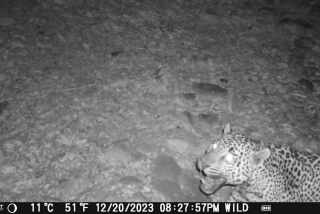CLIPBOARD : Breeding Bird: ROCK WREN (Salpinctes obsoletus)
- Share via
Description: The small, chunky rock wren has a slightly upturned bill. It is grayish-brown above with a streaked head and wings with light eyebrow markings slightly above dark eyes. Its vanilla breast and belly is marked with tan streaks. The black-banded tail shows orange-tipped outer feathers and a cinnamon rump when cocked. Length: 5 1/2 inches.
Habitat: Arid and semiarid canyons, dry washes and scrubland.
Diet: Not verified. Likely to be insects, earthworms and spiders.
Displays: Neighboring territorial males countersing using similar song types; each male has a repertoire of more than 100 songs. Breeding displays are unknown.
Nest: Built in a hole, crevice or under rocks, entrance is paved with fine stone chips. Nest is constructed of grass, rootlets and other materials, then lined with fine grasses.
Eggs: Light pink with deep rusty splotches, sometimes wreathed. Slightly under an inch long.
Call: Dry, trilling tik-keer ; song is a series of buzzes and trills.
Notes: Rock wren can be located by following a path of pebbles or rock chips to its nest.
Map indicates 5-kilometer-square areas where breeding activity has been confirmed.
Note: Map is divided into 5-kilometer squares so that Audubon Society volunteers can more easily survey areas on a regular basis.
Sources: Sea and Sage Audubon Society; “The Birder’s Handbook,” Ehrlich, Dobkin and Wheye, Fireside Books (1988); “Field Guide to the Birds of North America,” National Geographic Society (1987); “Birds of Southern California: Status and Distribution,” Garrett and Dunn, Los Angeles Audubon Society (1981).
More to Read
Sign up for Essential California
The most important California stories and recommendations in your inbox every morning.
You may occasionally receive promotional content from the Los Angeles Times.










